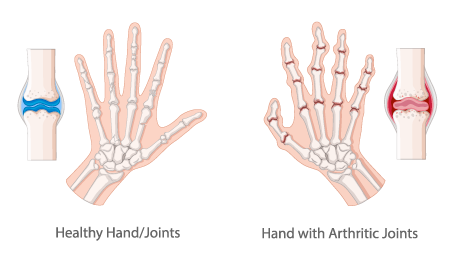Who Are We?
The hand is one of the most complex structures in the human body. It can perform countless actions, many of which are crucial to everyday life.
Musculoskeletal conditions such as hand osteoarthritis have a major impact on peoples’ confidence, independence and quality of life however our
understanding of hand and wrist joint diseases remains low compared to lower-limb joint disease.
‘How Would You HAND-le this?’ is a collaborative project which sees public contributors, engineers and health scientists develop an educational
and interactive resource to raise awareness of what it is like to live with hand osteoarthritis and communicate the importance of working with
members of the public to incorporate these lived experience insights in the design of healthcare technologies.
Lived Experience Perspective
Blog Posts from Individuals who Live with Hand Osteo-Arthritis
Gloria's Experience
Hi, my name is Gloria and I have been taking part in a hand arthritis public involvement study.
My symptoms are reasonably mild compared to the others involved, but they still impinge on my daily life.
It is mainly in damp weather when I get sharp pains and swelling.
This response mainly occurs in my thumbs, but also my fingers and wrists.
 The reason I decided to get involved in this study was that I already attended an exercise group run by the Senior Saint’s Foundation then,
Tina and Charlie came along to one of our sessions and they were impressed by the attitude of the participants.
We do not let anything get us down for long and we try to keep as fit as we can with all our various ailments; arthritis being the biggest one.
The reason I decided to get involved in this study was that I already attended an exercise group run by the Senior Saint’s Foundation then,
Tina and Charlie came along to one of our sessions and they were impressed by the attitude of the participants.
We do not let anything get us down for long and we try to keep as fit as we can with all our various ailments; arthritis being the biggest one.
This public involvement study has been really interesting as I did not even know that there was already a surgical procedure for the hands albeit
more invasive. I also found out that there are physio exercises you can do as well to help mobility in the hands.
Seeing the work being proposed to try to make this surgery more simplistic has been an eye-opener.
Having input about our feelings towards arthritis and what we do to carry on normal life has felt like we are at last being listened to as well.
I hope that more input from the patients will be taken into account as well in the future.
Tina and Charlie who were running these sessions were quite surprised by some of the things that are affected by arthritis and what we have to do
to overcome it. Simple things we take for granted like sewing, writing a letter, opening those childproof caps, or trying to.
Even gripping a bread knife or picking something up, when we are in the throes of a flare-up can be nigh on impossible.
Rather than keep taking anti-inflammatory and pain killer tablets, which merely mask the underlying problem, a simple but effective surgery at the
early stages would be preferable. This is not something that affects just “older” people; some as young as 14 have been diagnosed with arthritis.
The sooner it is diagnosed and the sooner a simple surgery to help, without removing good bone, can be performed, then a better quality of life can be had.
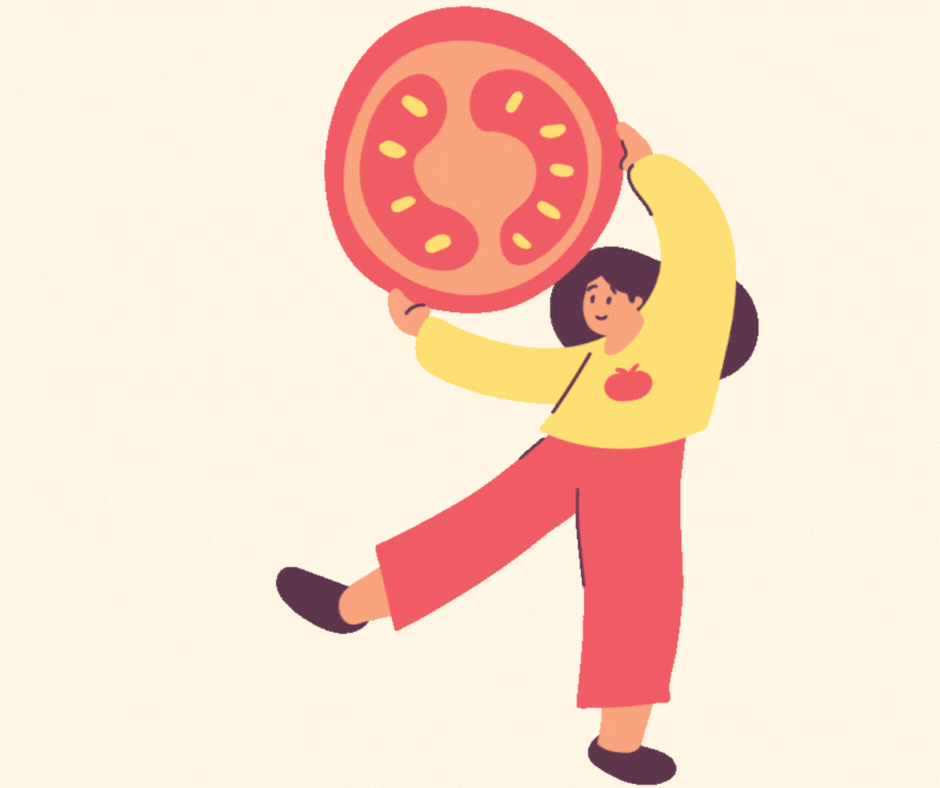 If this can be done under a local anaesthetic, all the better, as there is no long recovery required and you can be in and out in a day.
If it has to be repeated in 2,3,4 or even 5 years down the road then so be it, it’s better than trying to cope with the debilitating effects of arthritis.
As I said before it’s not just an older person’s disease and it should be taken more seriously in the early stages so as to nip it in the bud.
So many people could be helped with the possibility of this new procedure and by using what we already have in the arsenal like physiotherapy,
nutrition and diet to help with flare-ups. For example, some people are affected by the acidity of say “tomatoes” so ensuring you are eating things
that do not cause your flare-ups is important.
If this can be done under a local anaesthetic, all the better, as there is no long recovery required and you can be in and out in a day.
If it has to be repeated in 2,3,4 or even 5 years down the road then so be it, it’s better than trying to cope with the debilitating effects of arthritis.
As I said before it’s not just an older person’s disease and it should be taken more seriously in the early stages so as to nip it in the bud.
So many people could be helped with the possibility of this new procedure and by using what we already have in the arsenal like physiotherapy,
nutrition and diet to help with flare-ups. For example, some people are affected by the acidity of say “tomatoes” so ensuring you are eating things
that do not cause your flare-ups is important.
I hope you found this blog interesting.
Neri's Experience
I have been suffering from osteoarthritis (OA) in both of my hands since I was in my early teens.
Then I was finally diagnosed, here in the UK, when I was aged 40. I met Tina and Charlie in our Senior Saints Foundation exercise group when they
came to talk about their project with us. I told myself “I hope in the future there will be a discovery they can make for alleviating the pain of OA of the hand and wrist”.
Before we started our exercises, they asked questions about what it is like to live with OA.
 We shared things like what we have to do to ease the pain,
including things like doing exercise, as well as the different foods that make OA pain better or worse. Then I was so enthusiastic to learn about
their project and be involved with it further that I told them if they need more questions answered or if I can be of help to let me know.
Charlie said he will be contacting and sending us an email in the future so that’s how I was involved with this project.
We shared things like what we have to do to ease the pain,
including things like doing exercise, as well as the different foods that make OA pain better or worse. Then I was so enthusiastic to learn about
their project and be involved with it further that I told them if they need more questions answered or if I can be of help to let me know.
Charlie said he will be contacting and sending us an email in the future so that’s how I was involved with this project.
Our PPI sessions were interesting. It was fun sharing our knowledge and experience and interacting with researchers who are quite knowledgeable about their projects.
The sessions also involved giving our opinions on the APRICOT project, mostly regarding the choice of treatment and whether to use local or general anaesthetic for
such procedures. There were interesting bonus questions Charlie asked us in our last meeting. For example, we were given an example scenario of different
treatments, along with their pros and cons and asked which was the best choice. All of us agreed that the third option was the best for us.
This option would remove the pain and get the joint moving but might fail more often.
If option three doesn’t work then you can still have option one which is an implant that removes pain but feels different because it doesn’t restore natural motion.
Tina’s PPI group was not only interesting but very informative especially in the way that she took notes and put them on the Jamboard.
She was so very organised and her excellent technical skills with the computer meant that any points we made in our discussion were quickly put on the screen.
During our PPI sessions, we covered different things related to the general awareness of OA of the hand.
 For example, we talked about the lack of information
about the possible joint replacements for OA of the hand. Our group also mentioned that exercise is very important for the self-management of pain.
It helps to build up strength and to prevent more stiffness especially as we use our hands very often. Another thing mentioned was that our hands have
many joints and the joint structure is very complex and moves in different directions. We also covered treatment awareness and possible interventions
for relieving pain.
For example, we talked about the lack of information
about the possible joint replacements for OA of the hand. Our group also mentioned that exercise is very important for the self-management of pain.
It helps to build up strength and to prevent more stiffness especially as we use our hands very often. Another thing mentioned was that our hands have
many joints and the joint structure is very complex and moves in different directions. We also covered treatment awareness and possible interventions
for relieving pain.
For me, public involvement is important because you are getting all the information directly, not from books, journals, or other research but from
the patients with OA pain of the hands. Unlike OA in other parts of the body, I didn’t know there were more studies, research, and treatment for
OA of the fingers and hand in which is more debilitating because our hands are more crucial for us to function and do certain things with.
Discussion Outcomes
Infographic of the Daily Factors That Impact Individuals Living with Hand Osteo-Arthritis
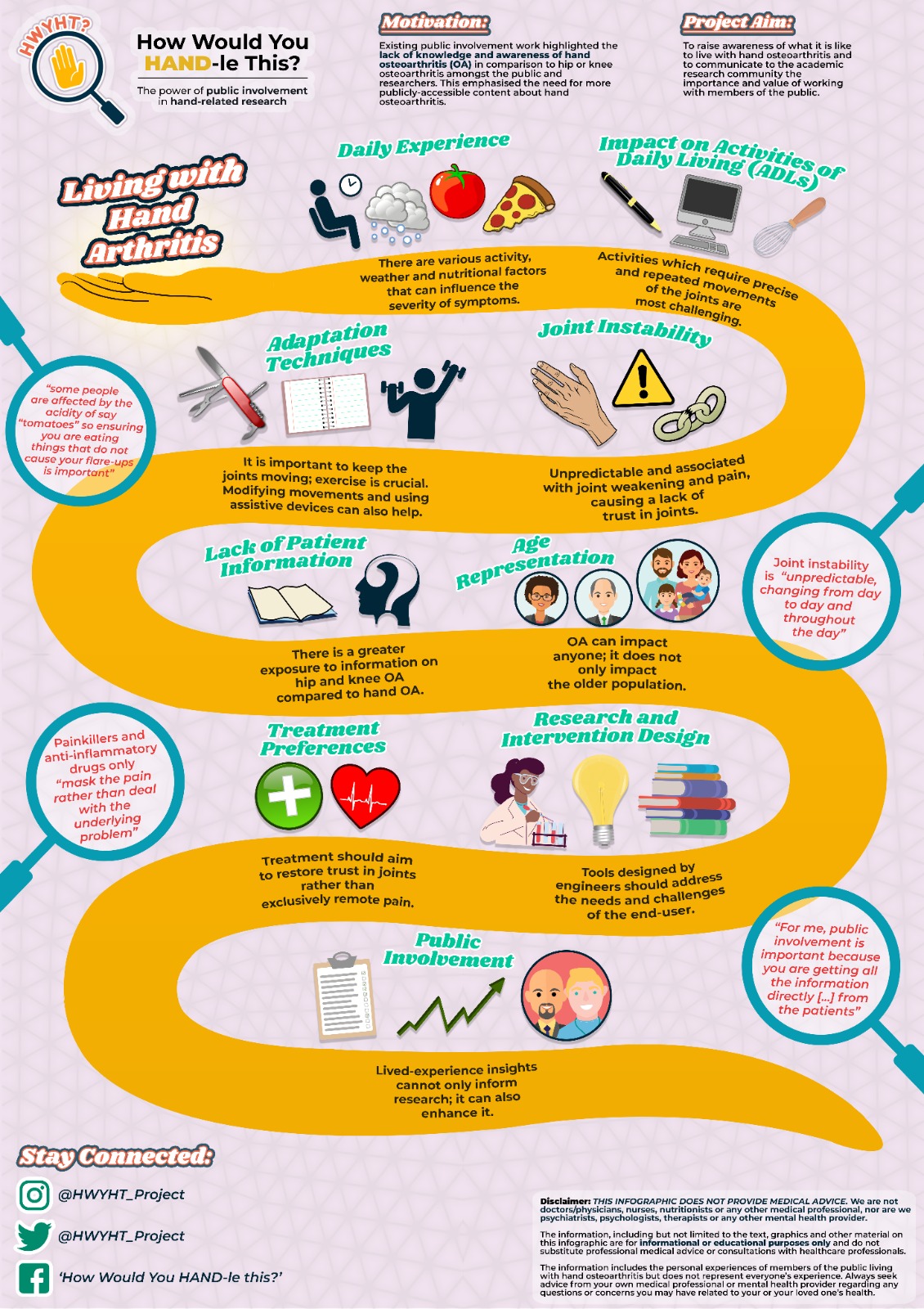
Researcher's Perspective
Blog Posts from the Researchers who are Raising Awareness of What Work is Being Done to Help Individuals Living with Hand Oste-Arthritis
Charlie's Perspective
Hello, I am an engineer/scientist working on research project developing a radically new type of implant to treat small-joint
arthritis; this project is called
APRICOT.
I believe this new implant will transform the lives of people with arthritis. However, it will only do this if it has the best possible team behind it.
 But what does this ‘best possible team’ look like? In recent years, we have come to realise how increased diversity in teams and listening to a
variety of voices improves the overall performance of the team. I see public involvement as a key mechanism to achieve this.
Why?
Most scientists/engineers/academics/clinicians developing treatments for arthritis don’t have it. As a result, they can’t fully empathise,
they can’t ‘feel’ what it’s like to live with arthritis – they need people with arthritis in the team to help all those involved in the project
fully understand the condition.
But what does this ‘best possible team’ look like? In recent years, we have come to realise how increased diversity in teams and listening to a
variety of voices improves the overall performance of the team. I see public involvement as a key mechanism to achieve this.
Why?
Most scientists/engineers/academics/clinicians developing treatments for arthritis don’t have it. As a result, they can’t fully empathise,
they can’t ‘feel’ what it’s like to live with arthritis – they need people with arthritis in the team to help all those involved in the project
fully understand the condition.
Seeing the work being proposed to try to make this surgery more simplistic has been an eye-opener.
Having input about our feelings towards arthritis and what we do to carry on normal life has felt like we are at last being listened to as well.
I hope that more input from the patients will be taken into account as well in the future.
If you’d have asked me before I started working on this project how to learn about arthritis I’d probably have said ‘read a book’.
 My assumption, therefore, was that everything I would need to understand what we know about arthritis would be written down.
I have come to realise this is not true(!). This is particularly hard for the scientific side of me to take, as I very much believe in the
scientific approach of seeing what all the relevant previous studies have found, and been shared in peer-reviewed publications, and working
from that point. However, this approach preferences certain types of information, and particularly things that can be measured in some way,
with things that are easier to measure sometimes getting a disproportionate amount of ‘airtime’.
My assumption, therefore, was that everything I would need to understand what we know about arthritis would be written down.
I have come to realise this is not true(!). This is particularly hard for the scientific side of me to take, as I very much believe in the
scientific approach of seeing what all the relevant previous studies have found, and been shared in peer-reviewed publications, and working
from that point. However, this approach preferences certain types of information, and particularly things that can be measured in some way,
with things that are easier to measure sometimes getting a disproportionate amount of ‘airtime’.
However, the world is rich and complex, and people know a lot (a lot!), and it is very hard to translate all this into scientific measurement.
Public involvement exposed me to how rich, diverse, and complex the interaction between arthritis and a person is. It allowed me to appreciate
that the reduction of arthritis that is presented in the scientific literature does not fully articulate what it truly is. When taken on its own,
without augmentation by conversations with people, it is possible to think that pain dominates the symptoms of arthritis, with some additional
features of joint stiffness and range of motion. Yet it is so much more than this, it’s also about your relationship with your body: can you trust
your joints, can you rely upon your body to perform when you’re looking after your grandchildren, can you still call yourself an independent person.
There is so much more to arthritis and if we, as a team, are going to transform lives with new technology – we had better make sure we understand
what it is we are trying to help with.
Perhaps there will come a time when scientists are able to measure and describe all that arthritis is and what it means so effectively, so accurately,
that anyone who wants to know about it can really just ‘read a book’.
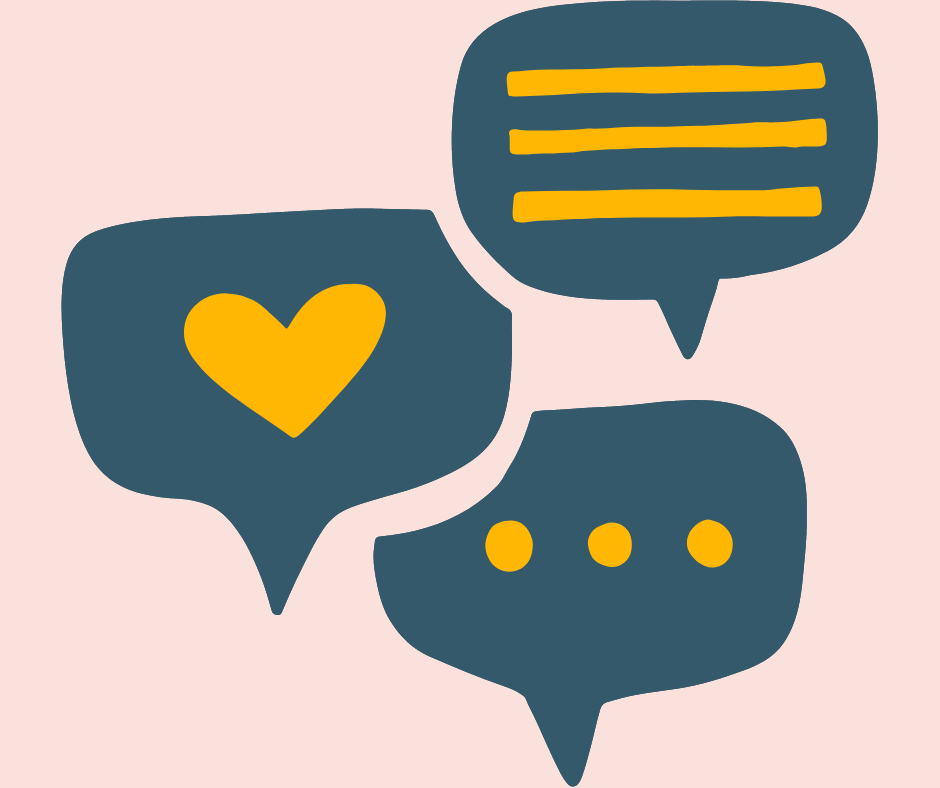 However, until then, we’ll need to keep talking to people with arthritis if
we want to truly understand what it is and what it means for people. This is why PPI is essential for our project, and why we are so grateful to our
public contributors for what they have given to the team.
However, until then, we’ll need to keep talking to people with arthritis if
we want to truly understand what it is and what it means for people. This is why PPI is essential for our project, and why we are so grateful to our
public contributors for what they have given to the team.
Tina's Perspective
Hello, I am a postgraduate researcher in the School of Engineering at the University of Southampton.
I started my PhD project, combining traditional computational modelling methods with public involvement, back in the autumn of 2020 but it was during
my final-year undergraduate group project that I first came across public involvement.
 This group design project concerned the design and manufacture
of a joint simulator to test the concept of a new implant for treating small-joint arthritis
(APRICOT project).
We sat in many meetings with surgeons and engineers to discuss the needs of a new implant however it wasn’t until it was suggested by one of my
supervisors that we realised that there was an expertise missing; the lived-experience perspective.
This group design project concerned the design and manufacture
of a joint simulator to test the concept of a new implant for treating small-joint arthritis
(APRICOT project).
We sat in many meetings with surgeons and engineers to discuss the needs of a new implant however it wasn’t until it was suggested by one of my
supervisors that we realised that there was an expertise missing; the lived-experience perspective.
It would be an understatement to say that attending the Saint Foundation OA support groups to talk with members of the public about our project changed
my entire perspective on research. It showed me that engineering continues to be technology-driven rather than patient-led. How can we expect people to
use the technology we design if we haven’t considered their perspectives or needs in the design process? One way to do that is by involving them at
every stage possible. For instance, where reducing pain is the main goal of surgical intervention, the Saint’s Foundation group was very vocal in
proposing that joint stability was a key biomechanical characteristic to improve; going as far as to state they would like to trust their joints again.
This is something we did not consider at the early stages of the project, but after introducing public involvement, ended up being a key testing
criterion for the final simulator.
Influenced by public contributions from the group design project, the PhD prioritised involving members of the public as early as possible.
Three public contributors whom we previously met during the group design project, volunteered their time to attend four virtual meetings to
discuss their lived experience with hand OA and the direction of the computational modelling work.
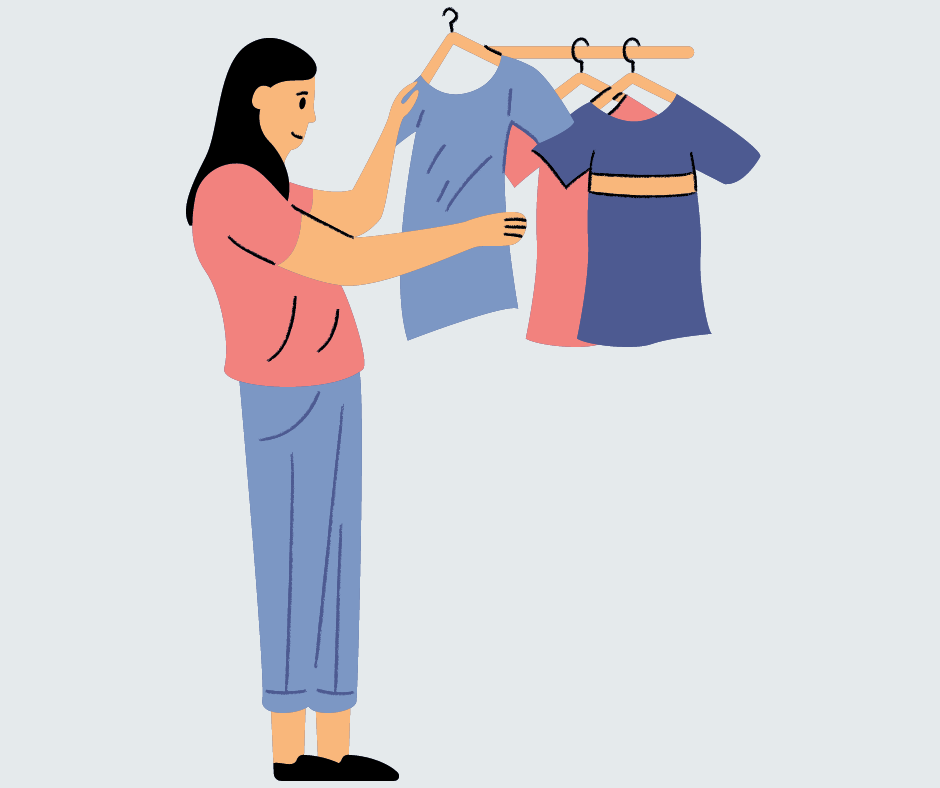 Many interesting conversations were sparked.
For example, learning that diet and clothing choice is a crucial part of daily living or that using electrical devices that aim to help perform a
task can sometimes make symptoms worse, are all considerations that are rarely discussed or addressed in the literature and yet as researches we
focus so heavily on the literature to inform our research questions.
As the sessions went on, we strengthened our relationship and found fun and
interesting ways to represent our discussions. At one point, we decided to create Google Jamboards,
Many interesting conversations were sparked.
For example, learning that diet and clothing choice is a crucial part of daily living or that using electrical devices that aim to help perform a
task can sometimes make symptoms worse, are all considerations that are rarely discussed or addressed in the literature and yet as researches we
focus so heavily on the literature to inform our research questions.
As the sessions went on, we strengthened our relationship and found fun and
interesting ways to represent our discussions. At one point, we decided to create Google Jamboards,
 using colours and mind maps to visualise everything
we were saying. These sessions weren’t about taking information from contributors; there was a mutual exchange of experience and mutual respect for
everyone involved.
using colours and mind maps to visualise everything
we were saying. These sessions weren’t about taking information from contributors; there was a mutual exchange of experience and mutual respect for
everyone involved.
We are still creating content in new ways; shifting from a consultation approach to a co-productive one. Since we have dived into more ways contributors
can get involved. The How Would You HAND-le this? Project would have never happened without them. In addition, with the PhD in full swing, they are
part of its Steering Group, staying in the loop and being part of the decision-making process. I hope that we can continue to work together and share
our experience with the wider community because it has been great to see how our partnership has evolved since we first met and how many more
opportunities we can create to share our work and communicate to researchers the value of public involvement. I hope in the future more biomechanical
engineers work with public contributors because with the public, we can share, collaborate and co-produce research/technology to ensure it is fit
for purpose.
